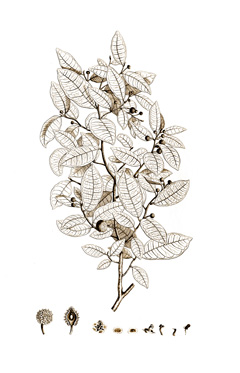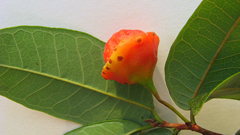 |
|
https://edibleplants.org/ |
 |
| Flickr - Alex Popovkin |
Translate this page:
Summary
Found in South America, Bastard breadnut or Brosimum guianense is a large, deciduous tree up to 40 m tall with trunk diameter of up to 70 cm. It has a straight, cylindrical bole and a dense, elongate crown. It is used medicinally as treatment for asthma and cold, as an analgesic (softened bark), and anthelmintic, bitter, and caustic (latex). The bark is a source of white latex that is thick and sticky. Bastard breadnut is widely exploited in the wild for its highly valued timber. The wood is extremely hard and heavy, strong, durable, and resistant to termites. The fruit pulp of this tree is consumed raw.
Physical Characteristics

 Brosimum guianense is a deciduous Tree growing to 25 m (82ft) by 20 m (65ft) at a fast rate.
Brosimum guianense is a deciduous Tree growing to 25 m (82ft) by 20 m (65ft) at a fast rate.
See above for USDA hardiness. It is hardy to UK zone 10.
Suitable for: light (sandy), medium (loamy) and heavy (clay) soils. Suitable pH: mildly acid, neutral and basic (mildly alkaline) soils. It can grow in semi-shade (light woodland) or no shade. It prefers dry or moist soil and can tolerate drought.
UK Hardiness Map
US Hardiness Map
Synonyms
Alicastrum guianense (Aubl.) Kuntze Brosimum aubletii Poepp. & Endl. Brosimum discolor Schott Brosim
Plant Habitats
Edible Uses
Edible Parts: Fruit
Edible Uses:
Edible portion: Fruit. The fruit pulp is eaten raw.
References More on Edible Uses
Medicinal Uses
Plants For A Future can not take any responsibility for any adverse effects from the use of plants. Always seek advice from a professional before using a plant medicinally.
Analgesic Anthelmintic Antiasthmatic Bitter
The macerated bark is warmed and used as an analgesic[ 348 ]. The latex is anthelmintic, bitter and caustic[ 348 ]. It is mixed with dairy milk and then drunk as a remedy for internal ulcers. It is drunk as a treatment for asthma and colds[ 348 ].
References More on Medicinal Uses
The Bookshop: Edible Plant Books
Our Latest books on Perennial Plants For Food Forests and Permaculture Gardens in paperback or digital formats.

Edible Tropical Plants
Food Forest Plants for Hotter Conditions: 250+ Plants For Tropical Food Forests & Permaculture Gardens.
More

Edible Temperate Plants
Plants for Your Food Forest: 500 Plants for Temperate Food Forests & Permaculture Gardens.
More

More Books
PFAF have eight books available in paperback and digital formats. Browse the shop for more information.
Shop Now
Other Uses
Furniture Latex Wood
Other uses rating: Very High (5/5). Other Uses: A thick, sticky, white latex is obtained from the bark[ 378 ]. The plant is exploited from the wild for its wood, which is highly sought after for specialist uses. It is one of the most expensive of woods, often sold by weight[46]. The tree is slow in forming heartwood, which is the only part used commercially. A tree of 35cm diameter may, on occasions, have only 2 - 10cm of heartwood, while a 50cm tree will ordinarily have not more than 18cm. The amount of heartwood is reported to vary according to location. Certain areas produce timber with considerable heartwood, while in other areas even large trees may not be worth felling[ 378 ] The heartwood is dark red to reddish-brown or brown, with black markings that resemble letters or hieroglyphs - the distinctiveness of these markings is reduced as the colour of the backgrounds is darkened by exposure; it is not clearly demarcated from the light, yellow to nearly white sapwood[ 46 , 378 ]. The texture is medium; the grain is straight; lustre medium; there is no distinctive odour or taste. The wood is extremely hard, extremely heavy, strong, very durable, resistant to dry wood termites[ 378 ]. Because of its hardness, the wood is worked with considerable difficulty, being difficult to cut and taking nails poorly, however, it finishes smoothly and takes a beautiful polish[ 46 , 378 , 420 ]. Because of the limited supply, small size, and high cost, the wood is best suited for speciality items that capitalize on its unusual beauty, hardness, and density. It is therefore mainly used for purposes such as inlay work, furniture, drum sticks, umbrella handles, fishing rods, fancy articles, violin bows, cabinetwork etc[ 46 , 378 , 420 ].
Special Uses
References More on Other Uses
Cultivation details
A plant of the lowland tropics, where it is found in dry to very humid regions[ 420 ]. Succeeds in a sunny to semi-shaded position. Plants are at least somewhat drought resistant[ 420 ]. Young plants normally establish well and grow away quickly[ 420 ]. Plants flower and fruit throughout the year. A monoecious species, but male and female forms need to be grown if fruit and seed is required.
References Carbon Farming Information and Carbon Sequestration Information
Temperature Converter
Type a value in the Celsius field to convert the value to Fahrenheit:
Fahrenheit:
The PFAF Bookshop
Plants For A Future have a number of books available in paperback and digital form. Book titles include Edible Plants, Edible Perennials, Edible Trees,Edible Shrubs, Woodland Gardening, and Temperate Food Forest Plants. Our new book is Food Forest Plants For Hotter Conditions (Tropical and Sub-Tropical).
Shop Now
Plant Propagation
Seed - best sown as soon as it is ripe in individual pots or a nursery bed in a sunny position[ 420 ]. Germination rates are usually above 50%, with sprouting occurring in a few weeks[ 420 ]. Plants grow away quickly. Root cuttings[ 420 ].
Other Names
If available other names are mentioned here
Bastard breadnut or Brosimum guianense
Native Range
NORTHERN AMERICA: Mexico (Chiapas, Oaxaca) SOUTHERN AMERICA: Belize, Costa Rica (southwest), Guatemala, Nicaragua, Panama (south), French Guiana, Guyana, Suriname, Venezuela (e. & n.w.), Brazil (Acre, Amazonas, Bahia, Espírito Santo, Maranhão, Mato Grosso, Minas Gerais (south), Pará, Pernambuco, Rio de Janeiro, Rondônia, Roraima, São Paulo, Sergipe), Bolivia, Colombia (north), Ecuador (Azuay, Esmeraldas, Morona Santiago, Napo, Pastaza, Sucumbíos), Peru (Huánuco, Loreto, Madre de Dios, Pasco)
Weed Potential
Right plant wrong place. We are currently updating this section.
Please note that a plant may be invasive in one area but may not in your area so it's worth checking.
None Known
Conservation Status
IUCN Red List of Threatened Plants Status : This taxon has not yet been assessed.

Growth: S = slow M = medium F = fast. Soil: L = light (sandy) M = medium H = heavy (clay). pH: A = acid N = neutral B = basic (alkaline). Shade: F = full shade S = semi-shade N = no shade. Moisture: D = dry M = Moist We = wet Wa = water.
Now available:
Food Forest Plants for Mediterranean Conditions
350+ Perennial Plants For Mediterranean and Drier Food Forests and Permaculture Gardens.
[Paperback and eBook]
This is the third in Plants For A Future's series of plant guides for food forests tailored to
specific climate zones. Following volumes on temperate and tropical ecosystems, this book focuses
on species suited to Mediterranean conditions—regions with hot, dry summers and cool, wet winters,
often facing the added challenge of climate change.
Read More
Expert comment
Author
(Aubl.) Huber
Botanical References
Links / References
For a list of references used on this page please go here
A special thanks to Ken Fern for some of the information used on this page.
Readers comment
| Add a comment |
|
If you have important information about this plant that may help other users please add a comment or link below. Only comments or links that are felt to be directly relevant to a plant will be included. If you think a comment/link or information contained on this page is inaccurate or misleading we would welcome your feedback at [email protected]. If you have questions about a plant please use the Forum on this website as we do not have the resources to answer questions ourselves.
* Please note: the comments by website users are not necessarily those held by PFAF and may give misleading or inaccurate information.
To leave a comment please Register or login here All comments need to be approved so will not appear immediately.
|
Subject : Brosimum guianense
|
|
|
|